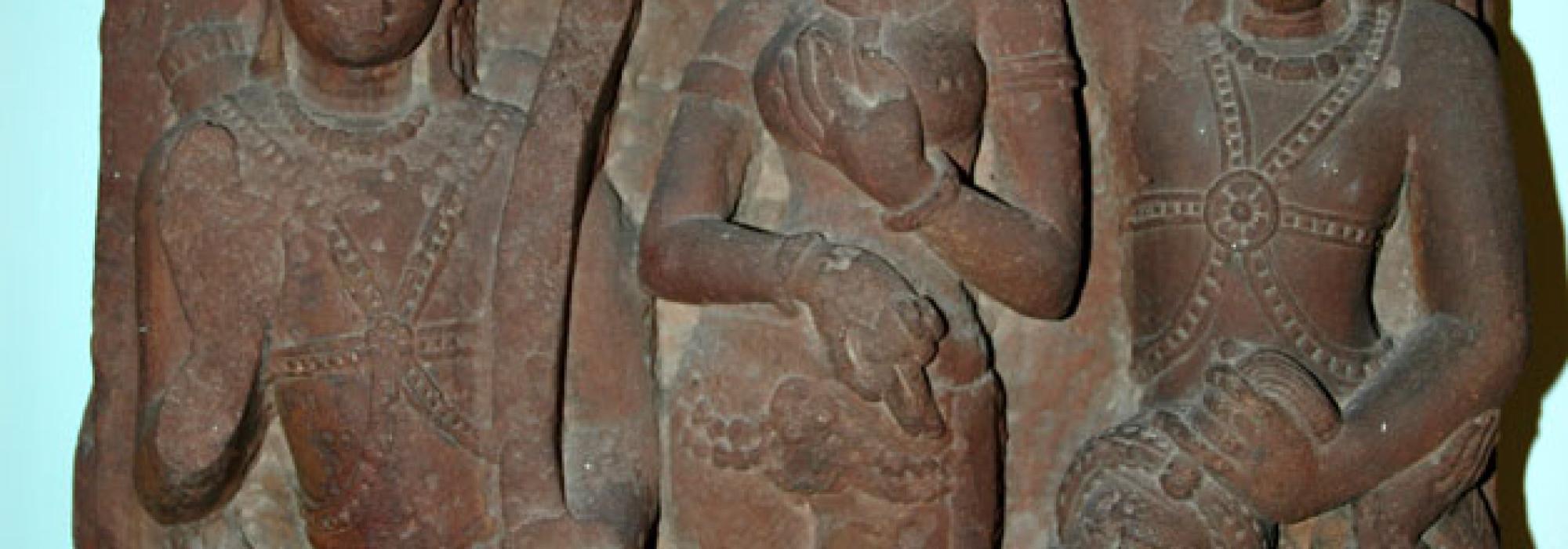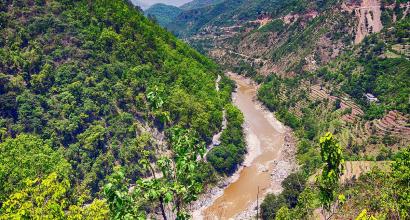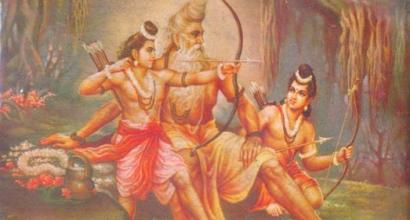As Rāma and Lakṣmaṇa sat along with Sītā in leaf hut engrossed in conversation, a rākṣasī named Śūrpaṇakhā, the sister of the ten-headed rākṣasa Rāvaṇa happened to come there. As soon as the rākṣasī saw Rāma, she grew infatuated with him. While Rāma was handsome, she was ugly; he was slim and she had a huge tummy; he had wide eyes, and her eyes were crooked; his voice was sweet and hers struck terror. He was young, noble, and well mannered, while she was old, repulsive, and ill mannered. Yet, she was overpowered by love and asked Rāma, “You look like a tapasvī and have come with your wife to this region, inhabited by the rākṣasas. Who are you?”
Rāma introduced himself, his brother, and wife, and asked who she was. Śūrpaṇakhā replied, “Listen, Rāma. My name is Śūrpaṇakhā and I can take any form at will. I roam around in the jungle all alone and cause fear to everyone. The lord of all rākṣasas, Rāvaṇa is my brother and so is Kumbhakarṇa who is ever asleep; Vibhīṣaṇa is my brother as well, but he is dhārmic and does not possess any characteristics of the rākṣasas. Khara and Dūṣaṇa are my brothers too and are known for their might in the war. But, I am prepared to do away with them all. I have approached you considering you my husband. Why do you want Sītā? She is ugly and unworthy of you. I alone am suited to you; be my husband forever. I will tear apart that ugly slut as well as your brother and eat them up. We will then roam around the forests and mountains, my beloved!”
With a smile, Rāma said, “But I am already married, respected one, and I love my wife too. For women like you, to have a co-wife, will be extremely sorrowful. My younger brother there is handsome, noble, majestic, and unmarried. He will make a good husband and is worthy of your beauty.”
Śūrpaṇakhā, wild with desire, approached Lakṣmaṇa, and sought to marry him. Lakṣmaṇa replied, “Why would you marry a servant, O beautiful one? I act as per the will of my brother. Marrying a servant will make you a servant as well. You should better become the junior wife of my brother. With you by his side, his fortunes will prosper and he will soon do away with his older, ugly wife.”
Śūrpaṇakhā, who was unused to being teased and ridiculed, believed Lakṣmaṇa’s words. Infatuated with desire, she once again addressed Rāma who was sitting with Sītā in front of his cottage, “It is because of this unchaste woman, you do not care for me. I am going to devour this human right away and then shall live happily with you!” With her eyes burning like firebrands, she rushed towards the doe-eyed Sītā and looked like the very noose of Mṛtyu. Rāma restrained her and instructed Lakṣmaṇa, “We must never ridicule these savage rākṣasas. Vaidehī is holding on to her life with great difficulty. You must disfigure this ignoble and lustful rākṣasī.”
As Rāma looked on, Lakṣmaṇa pulled out his sword and chopped off the evil creature’s nose and ears. The terrifying Śūrpaṇakhā let out an ear-splitting roar and cried incessantly as she disappeared into the thick forest with her arms outstretched. She went to her brother Khara, who was in the company of many other rākṣasas, and fell to the ground. Overcome with immense rage and confusion, the mutilated rākṣasī with blood dripping from her body, narrated to her brother everything that had taken place.
Enraged, Khara declared, “I will slay the person right away. Once you gain back your senses, name the person whose blood the earth should drink today and has caused you so much of pain!”
Śūrpaṇakhā said, “Two handsome men, who were in the company of the most beautiful woman I have seen, brought me to this state. The men wore matted locks of hair and were clad in backcloth, while the lady was decked with jewellery. Dear brother, my fondest wish right now is to drink her blood and theirs in the battlefield.”
Khara immediately sent fourteen of his rākṣasas and Śūrpaṇakhā showed them Rāghava’s āśrama. Rāma recalled the request of the ṛṣis, mounted fourteen arrows, and shot them at once at the rākṣasas. They were vanquished in no time. Śūrpaṇakhā was terrified, and with her blood hardly dry, she went back to her brother and fell before him on the ground, like a broken creeper with its sap oozing out. She declared, “I will take my own life before your eyes, if you don’t slay Rāma today. In fact, I think you simply pretend to be valorous, but you don’t dare to face Rāma!”
Belittled by Śūrpaṇakhā, Khara was even more enraged and got an army of fourteen thousand rākṣasas ready. He rode on a brilliant chariot and lead the army along with Dūṣaṇa. He invigorated his men and urged his charioteer, roaring like a storm cloud bursting with a shower of hailstones. As they went ahead, a rumbling cloud, red like a donkey, showered down water red as blood. The horses of Khara’s chariot stumbled and a dark, blood-rimmed disk covered the Sun. Carnivorous birds and animals including jackals encircled Janasthāna and let out ghastly howls. A headless corpse appeared near the sky and Svarbhānu, who causes eclipses engulfed the sun. Lotuses withered, and fruits and flowers fell off from trees. A tremor passed through the earth. Khara’s left arm throbbed and his voice chocked. His eyes were filled with tears and he had a shooting pain in his head. But, deluded by his strength, Khara would not turn back even when faced with terrible omens. Devas, gandharvas, and ṛṣis appeared in the skies and hoped to see Rāma victorious for the welfare of the world.
Rāma observed the bad omens and marked that a deadly battle would soon take place. He asked Lakṣmaṇa to arm himself and take Sītā to refuge in an inaccessible mountain cave. Rāma donned his armour and looked like smokeless flames blazing up in the dark. The sound of his twanging of the bowstring resonated in the skies. Consumed with fury, the rākṣasas attacked Rāma with war hammers, lances, arrows, swords, and axes. The weapons struck Rāma and his whole body was smeared with blood. He looked like the Sun enveloped by clouds during the hours of twilight. He flew into a rage, and shot hundreds and thousands of arrows. He thus killed innumerable rākṣasas. The evil doers then started showering boulders and trees upon him. Dūṣaṇa tried to attack Rāma with an iron club, but Rāma’s arrows chopped off his arms. The rākṣasa fell dead to the ground like an elephant with its tusks shattered. In no time, Rāma single-handedly vanquished the fourteen thousand rākṣasas.
The three-headed rākṣasa Triśiras raced towards Rāma, only to be slain in an instant. Khara advanced towards Rāma like a moth nearing fire. The rākṣasa shattered Rāma’s bow and shot seven arrows at his armour. The armour fell off and the arrows pierced his limbs. Enraged, Rāma picked up the mighty bow of Viṣṇu which the seer had gifted him and shot arrows which destroyed Khara’s chariot and killed his charioteer. Rāma picked up the arrow gifted to him by Indra, shot it at Khara’s chest, and the rākṣasa fell to the ground. The arrow burned him just as Rudra has burned down Andhakāsura in the past.
The great seers who had assembled there jubilantly lauded Rāma. Lakṣmaṇa and Sītā came out from the mountains and Sītā warmly embraced her husband, for he had slain his enemies and brought peace to the maharṣis.
Now, as Śūrpaṇakhā saw that Rāma had single-handedly slain fourteen thousand rākṣasas along with Khara, Dūṣaṇa, and Triśiras, she let out a deafening roar and rushed to Laṅkā. She found Rāvaṇa sitting on the terrace of his splendid palace along with his ministers. He was broad-chested, wide-mouthed, wore golden earrings, and was as tall as a mountain. The marks of hundreds of wounds from his battle with the devas including blows from Viṣṇu’s cakra could be seen on his body. He was adhārmic, caused troubles to all yajñas, and violated other men’s wives. He had defeated Vāsukī in the city of Bhogavatī and had abducted Takṣaka’s wife. He had gone to the Mount Kailāsa, defeated Kubera, and had stolen his flying chariot, the Puṣpaka. He would extend his might arms and block the paths of Candra and Sūrya. He had performed tapas for ten thousand years and had chopped off his heads as offerings to Brahmā. He had no fear of death from any of the beings – devas, gandharvas, dānavas, piśācas, birds, and serpents – except humans. He was cruel and derived pleasure from the misfortune of others. He was Rāvaṇa, the terror of the worlds. Looking at him, Śūrpaṇakhā, who once lived free from fear told him the terrifying story of the way she had been mutilated. Looking at her disfigured from, Rāvaṇa’s eyes grew wide and blazed with anger.
Śūrpaṇakhā in her rage addressed Rāvaṇa with these harsh words: “You are so absorbed in sensual pleasures that you ignore the presence of terrible danger. When a king is slave to his carnal passions, his subjects see him no better than cremation fire. A ruler who has no control over himself and does not gather information through his spies, is shunned by his people. Just as mountains under the ocean are not seen in all their glory, the riches of kings like you will soon disappear. You have made no use of spies and are unaware that your own people have been massacred in Janasthāna. Rāma, the tireless warrior, has assaulted Janasthāna, killed fourteen thousand rākṣasas including our brothers, and has provided security for ṛṣis in Daṇḍakāraṇya. In times of trouble, no one helps a king who has been cruel, treacherous, and negligent. When he is arrogant and aloof, even his own people will kill him. Even dry logs of wood or lumps of mud are useful, but not a king who has fallen from his seat of power. A king, who is ever awake in his governance, even though his eyes are closed in his sleep, will be honoured by his people. You are stupid, Rāvaṇa, and lack the qualities required of a king!”
As Śūrpaṇakhā listed his shortcomings, Rāvaṇa listened with attention, and then started reflecting upon his own nature. Driven by rage, he asked his sister, “Who is Rāma and what does he look like? How powerful is he? And why has he entered the Daṇḍakāraṇya? What kind of weapon did he use to kill all the rākṣasas?”
Śūrpaṇakhā spoke, as though losing herself out of anger: “Rāma has long arms and large eyes. Though clad in bark cloth and deer-skin, he looks like Kandarpa – the deity of love. He is the son of Daśaratha and using his powerful bow, he shoots arrows that look like poisonous snakes. He was so swift that I could not even see him mounting arrows on his bow, but only see rākṣasas falling dead, many at a time. I barely escaped from him. Although he humiliated me, he spared me as he did not want to kill a woman. He has a mighty brother, as powerful as him – his name is Lakṣmaṇa. He loves his elder brother and is devoted to him. He is always on the side of Rāma like his right arm. He is like the very life-breath of Rāma, outside his body. Rāma’s dharma-patnī is Sītā, who hails from Videha. I have never seen a devī, gandharva, yakṣa, or kinnara woman who is as beautiful as her. Whoever is married to Sītā and is delightfully embraced by her, would be the happiest man on earth. She is a woman of good character with matchless beauty. She would make a perfect wife for you and you will be the best husband for her. As soon as you see her charming face, you will surely be afflicted by Manmatha’s arrows. If you want her as your wife, put your right leg forward and head out right away. You should also do a favour to the rākṣasas by killing the wicked Rāma.”
Upon hearing Śūrpaṇakhā’s hair-raising narration, Rāvaṇa carefully thought over the matter, weighed the pros and cons, and decided firmly what he should do. He went to the yāna-śālā, got ready a chariot pulled by donkeys, and got on to it. The ten-headed and twenty-armed rākṣasa travelled in the golden chariot, which would go to any place at his will. He crossed over the ocean and spotted a huge banyan tree named Subhadra. It was on to one of its branches that, long ago, Garuḍa had come carrying a huge tortoise and an elephant as his food. But due to the weight of Garuḍa, the branch on which he had momentarily perched, gave way. On the great branch were paramarṣis including the vaikhānasas, māṣas, and vālakhilyas. To save them, Garuḍa had caught the branch with one claw and stopped it from falling. He feasted upon the elephant and tortoise, and brought peace to the region by vanquishing the realm of the Niṣādas. He freed the munis and now, with double the enthusiasm, went to fetch amṛta. Breaking through the iron fences, Garuḍa fetched amṛta from Indra’s abode. There, Rāvaṇa saw the rākṣasa Mārīca, who had matted hair and was clad in deer-skin and bark cloth.
To be continued...
[The critically constituted text and the critical edition published by the Oriental Institute, Vadodara is the primary source. In addition, the Kannada rendering of the epic by Mahāmahopādhyāya Sri. N. Ranganatha Sharma and the English translation by Sri. N. Raghunathan have been referred.]














































